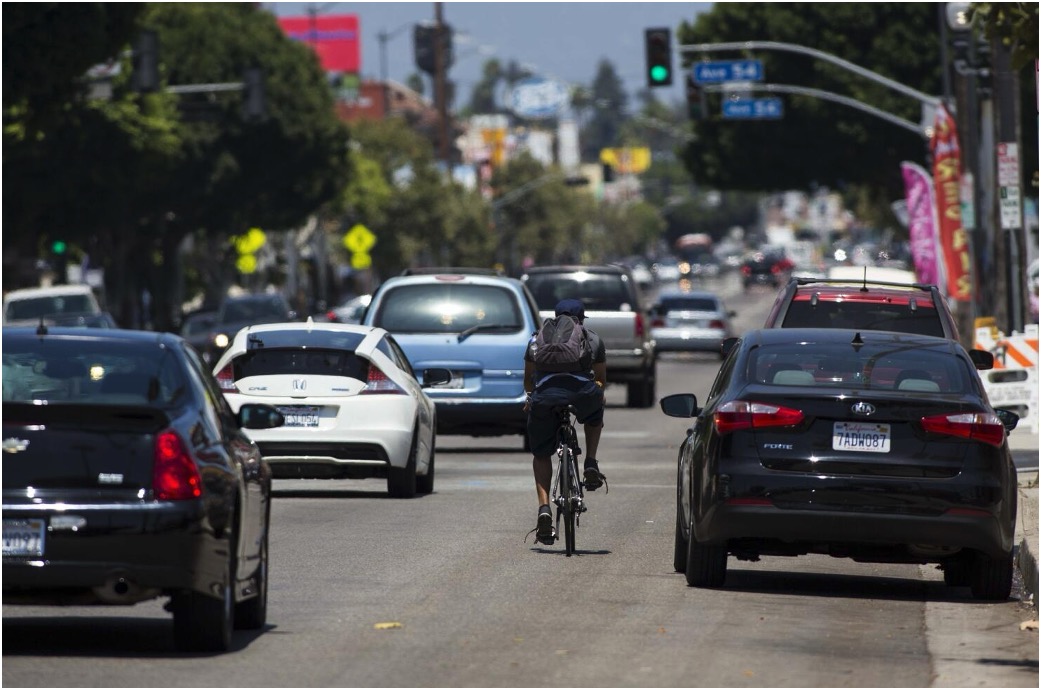Comments
PLANNING WATCH - Last week I wrote about bicycling in Los Angeles. Despite nearly perfect weather; many wide and flat streets; City, County, METRO, and regional bicycle plans; and enormous participation in mass CicLAvia bicycling events, Los Angeles has an anemic bicycle lane system and, unsurprisingly, low bicycle riding levels. Meanwhile other large cities, like New York, demonstrate how city government can successfully support bicycling. Not only is New York City large, with heavily congested streets, but it has many areas, like bridges (See photo above), that require substantial investment to build a safe, connected bicycle network.
Based on comments I received; some people blame LA’s second-rate bicycle infrastructure and low bicycling rates on the city’s size. Others argue that Angelenos are too busy to bike to work. While these explanations account for a small amount of LA’s minimal bicycling, two other factors account for most of the LA area’s low bicycling levels.
- Cycling must be safe, which means bicycle lanes must be separated from cars.
- Bicycle lanes must physically connect to each other, without gaps.
Without those features, Los Angeles will never become a bicycle-friendly city.
Another set of comments dealt with a recently adopted motion from the Mid-City West Neighborhood Council to retrofit a short bike lane on Fairfax Avenue, from Wilshire Avenue to Colgate Avenue, about a half-mile to the north. As much as I support bicycling done right in Los Angeles, I am skeptical of this motion’s six justifications:
Justification #1: “It [a Fairfax bicycle lane] calms traffic around Hancock Park Elementary, a site where many students cross the street.”
Critique: Fairfax has two crossing guards at Colgate Avenue. They make sure Hancock Park students can safely cross the busy street. Not only will this safety feature remain, along with a new guard on Colgate, but most students arrive by car. Their parents drop them off and pick them up at the school’s Colgate entrance.
Justification #2: “It implements Metro’s First/Last mile plan for Fairfax.”
Critique: METRO paid consultants to prepare a Draft First/Last Mile Plan for the Purple/D Line subway stations at LaBrea, Fairfax, and LaCienega. But METRO ended its role in 2021, when the draft then became an unimplemented shelf document.
Justification #3: “It provides a way for people to get from the future Purple -D Line stations to The Grove, Pan Pacific Park, and Television City without having to use a car.”
Critique: These destinations are at least a quarter-mile from the proposed bicycle lane. Bicyclists would then need to travel next to moving cars on some of the most traffic-congested streets in Los Angeles. Once they made it to The Grove or Farmers Market, they would discover that The Grove removed its bicycle parking several years ago. As for CBS Television City, Hackman Capital bought the site in 2017 and intends to build sound stages in lieu of live television.
Justification #4: “It provides a key-north/south bike lane corridor, which is otherwise difficult with Park LaBrea’s private streets and Carthay Circle’s lack of grid.”
Critique: Park LaBrea’s only functioning bicycle lane is on Hauser Boulevard, between 3rd and 6th streets, about a half-mile from the proposed Fairfax bicycle lane.
Justification #5: “It will connect with the future protected bike lane on 6th Street.”
Critique: There is a 6th Street bike lane on the Mobility Element’s Enhanced Bicycle Network (Map D1), but there are no plans or funds to build it. Meanwhile, a pared down road diet on 6th Street resulted in minor changes, without any consideration for a bicycle lane.
Justification #6: “It allows cyclists to get from Mid City West slow streets to the D Line station.”
Critique: The Slow Street Network crosses Fairfax Avenue at Rosewood Avenue. Brave cyclists would need to bike on a car-packed Fairfax Avenue for a half-mile to reach the new bike lane.
If proposals like a short, disconnected Fairfax Avenue bicycle lane don’t pass the smell test, what could be done to make Los Angeles a bicycle friendly city?
Not many bikers in Los Angeles are willing to ride on busy streets next to moving cars.
- Bike lanes should be protected from traffic. Since Los Angeles only has about 19 miles of protected bike lanes, there is much work to be done.
- New bike lanes should connect with existing lanes. What good is a new bicycle lane if it forces bicyclists to tempt fate by riding solo in heavy traffic to link up with another bicycle lane?
- Streets with bike lanes must be smooth. Nearby cities, like Beverly Hills, do this, which means Los Angeles can also rid its streets of potholes, ruts, and bulges.
- Mass transit, such as the Purple/D Line subway under construction on Wilshire Boulevard, must incorporate first-last mile features. This includes bicycle infrastructure; upgraded sidewalks and streets; streetscape and street furniture; parking structures; way-faring signs; street and sidewalk lighting; and station interfaces for cars, taxis, busses, pedestrians, scooters, and bicycles.
These four criteria would help create a bicycle-friendly Los Angeles. The open question is whether City Hall officials and grass roots bicycle advocates see the big picture and are up to the challenge.
(Dick Platkin is a retired Los Angeles city planner who reports on local planning issues for CityWatchLA. He is a board member of United Neighborhoods for Los Angeles (UN4LA).
Previous columns are available at the CityWatchLA archives. Please send questions to [email protected].)

















